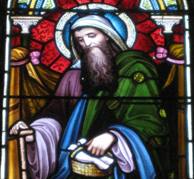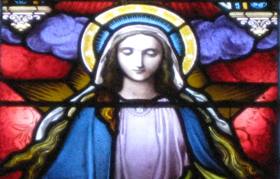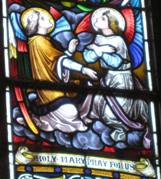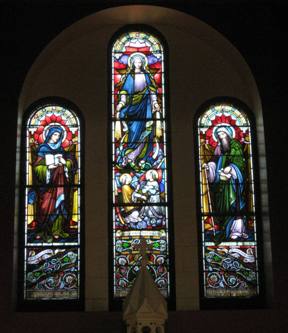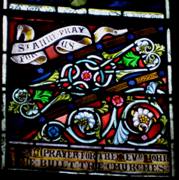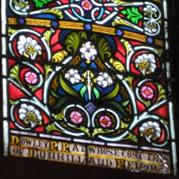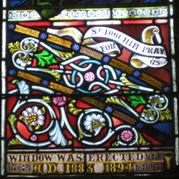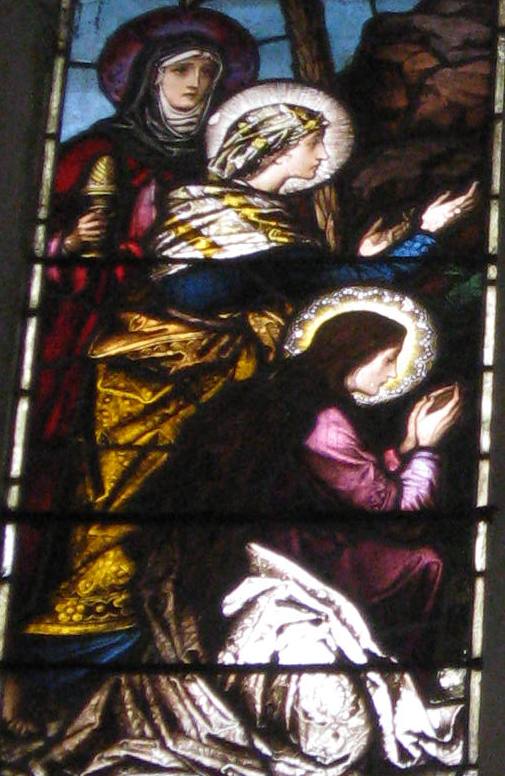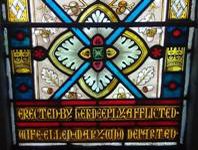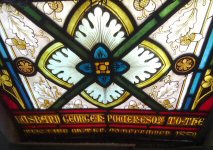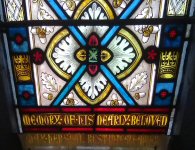Category Parish Churches
Our Lady’s window
Our Lady’s window
Our Lady is standing on a cloud above two angels who are kneeling on another cloud. She has her left foot on the head of a green snake or serpent. Our Lady is often seen crushing the head of the serpent in pictures and statues. It comes from a vision that St. Catherine Labouré received in 1830.
This is the serpent that tempted Eve in the Garden of Eden. It is often portrayed, as above, with a red apple in its mouth but, in fact, the type of fruit is not mentioned in the bible –
“Now the serpent was more crafty than any other beast of the field that the Lord God had made. He said to the woman, ‘Did God actually say, “You shall not eat of any tree in the garden”?'” [Genesis 3:1].
“So when the woman saw that the tree was good for food, and that it was a delight to the eyes, and that the tree was to be desired to make one wise, she took of its fruit and ate, and she also gave some to her husband who was with her, and he ate.” [Genesis 3:6].
In the Genesis story, the serpent represents evil or its personification, Satan. So the window shows Mary defeating evil.
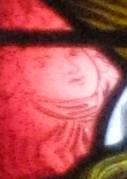
Did you notice the peculiar faces to the left and right of Mary’s head and shoulders? Click on the image to enlarge it and you will see the faces more clearly. Who do you think they are? Notice, too, the beautiful golden robe that one of the angels is wearing. The banner below the two angels says, “Holy Mary pray for us”.
The East Gable Windows
The East Gable Windows


There are four small windows in the peaks of the four gables. This one, in the east gable, is the smallest of the four. It is difficult to see from inside the church as it is partially obscured by the roof woodwork and by its surrounding masonry. Here we have shown an inside and an outside view.
These are the main windows in the church. The central window is partially hidden by the pinnacle of the main altar. Three figures are shown in the windows. They are, from left to right, Saint Anne, Our Lady, and Saint Joachim.
In the image on the left we ask, “St Anne Pray For Us” and, on the right, “St Joachim Pray For Us”.
The dedication at the bottom of the window is shown in the following three images.
HE BUILT THE CHURCHES |
OF DUNHILL AND FENOR |
A.D. 1883 1894 |
Fenor Church Windows
The Stained-Glass Windows of Immaculate Conception Church, Fenor
Did you ever stop and look at the stained-glass windows in the church? Possibly not. It’s not something that we do unless we are particularly interested in stained glass, and many of us aren’t. Anyway, it’s not easy to get a good, close look at them. A pair of binoculars is useful but the arms get tired very quickly. A camera is the thing! Modern cameras are equipped with lots of pixels which means that they can capture lots of detail. When viewed on the screen of a television or a computer the images may be enlarged by “zooming in”. It is only then that the amazing colours and fine detail of the windows can be fully appreciated. Not even by perching on the window ledges can you see the windows as well as you can here.
We will begin with the main window in the east gable, above the altar, and then turn left through the north transept, the north wall of the nave, the south wall of the nave, the south transept and, finally, the west gable window above the main door. This is the order adopted in the menu opposite,
Before you set off to view the windows of Fenor church, you might like to look at the window below. It is a detail from a window in St. Carthage’s cathedral in Lismore, Co. Waterford, and shows three women at Jesus’ tomb after the resurrection. According to Luke’s gospel they were Mary Magdalene, Joanna, and Mary the mother of James. Click the image to zoom in.

After Restoration
After Restoration
Some of the photos supplied by Colette Langan are displayed below without comment. They are all photos that were taken after restoration was completed..





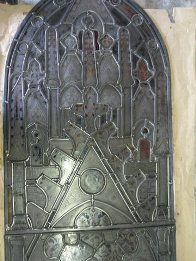

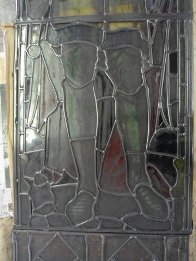
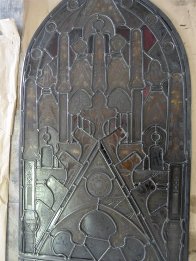



Before Restoration
Before Restoration
Some of the photos supplied by Colette Langan are displayed below without comment. They are all photos that were taken before restoration was completed. Some were taken with the windows still in situ and others were taken during different stages of the restoration process.














Window Restoration Dunhill
Window Restoration in Sacred Heart Church, Dunhill
The stained-glass windows in Sacred Heart church are in need of repair and restoration. Two windows were completed in September, 2011 – those of St. Michael the Archangel and St. John the Baptist, both in the south transept.
The windows were restored by Irish Stained Glass, and Colette Langan supplied us with photographs of the windows in their various stages of repair. The photos of these two windows, before and after restoration, may be viewed by choosing from the menu at top left.
Under the “South Transept Windows” menu selection you can see these windows as they are now in the church – completely restored.
The Agnus Dei Window
The Agnus Dei Window
![]()

Of the three east gable windows, this is the window on the right. The main detail shows a lamb holding a staff surmounted by a cross and a banner. The banner itself also bears a cross. In this image the lamb symbolically carries the cross and banner as it merely touches the staff with its right front hoof. In religious art such an image is known as an Agnus Dei (Lamb of God, in Latin). Sheep and lambs have been sacrificial animals for thousands of years. In Judaism a lamb, known as the Paschal Lamb, was sacrificed on the eve of the Passover to commemorate the night when God took the lives of the first born sons of the Egyptians and spared or passed over the first born sons of the Israelite slaves. The commemorative Passover sacrifice took place in the court of the Temple at Jerusalem and was usually a ram lamb, one year old and without flaw.
The Pelican Window
The Pelican Window
![]()

Of the three east gable windows, this is the window on the left. The main detail shows a pelican in its nest with four chicks. The pelican is vulning – pecking at its breast to draw blood with which to feed its young, and three drops of red blood are visible at the tip of its beak (you may have to enlarge the image to see them). The “Pelican in its Piety” is a symbol of Christ’s passion.
The East Gable Window
The East Gable Window
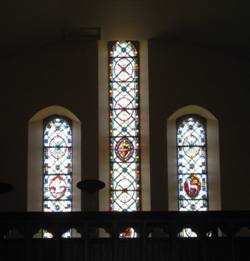
This is another difficult window to photograph as it is partially hidden by the gallery and the ceiling. The complete window may be viewed from the gallery itself but, there, the window is very close to the camera and a wide-angle lens is necessary to photograph the whole window or even just the tall central window. A trickier solution is to straddle the balcony of the gallery and lean out into space while holding the camera at arms length – without falling down into the aisle or dropping the camera. Some of the photos were taken in that way.
There are three windows in the east gable: the Pelican window on the left, the Sacred Heart window in the middle, and the Agnus Dei window on the right.
A dedication is written across the bottom of the three windows but this is impossible to see in any single image of the three windows and is difficult to see even in separate images as it is obscured by internal protective glazing. The dedication is shown below in the three photos.
| ERECTED BY HER DEEPLY AFFLICTED HUSBAND GEORGE K. POWER ESQRE TO THE MEMORY OF HIS DEARLY BELOVED WIFE ELLEN MARY WHO DEPARTED THIS LIFE ON THE 20 DECEMBER 1880 MAY HER SOUL REST IN PEACE AMEN |



